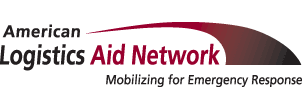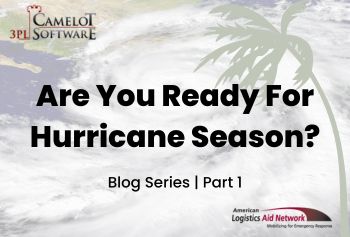Hello 3PL friends,
June 1 marks the official start of Hurricane Season. With this date on the horizon, Camelot has teamed up with ALAN to educate and inspire our 3PL partners to take action for the betterment of our local communities and those in need. Please stay tuned for our 4-part blog series offering different insights into the various ways you can protect yourself and help other members in the community who may need assistance.
Kicking it off, Hurricane Preparedness Week is upon us. Our goal this week is to inform 3PLs how to create, update, and reinforce their action plans. As a dear friend, colleague, and mentor, Sandy Vosk, has always said “Failure to Plan, is planning to Fail.”
With Hurricane Season quickly approaching, it’s important to shore up the defenses back at home. Creating a plan of action reinforces safety and resilience, as well as supporting business continuity to help you get back on your feet quickly after a disaster strikes. Whether it’s a hurricane, tornado, earthquake or a lost driver backing into the only power lines that supply your facility, having both Communications and Business Continuity Plans are essential. This blog will offer additional tips to help you bolster your plans today!
Geoff Greenhill, Director of Sales, Camelot 3PL Software
Is your business located in a coastal area or region that is historically at risk for hurricane landfall and impact? Do you have additional facilities, warehouses or remote employees operating in coastal zones? Or do you outsource material from regions that are geographically at risk for hurricane damage or employ truck drivers who frequently drive along coastal routes?
The more you think about it, the more you realize Hurricane Season has the potential to impact some facet of your organization. In order to ensure your safety and the safety of the employees under your leadership, spend the month of May with the following in mind:
Put People First
During a hurricane, your employees’ (and your) personal safety should always take precedence. In light of that, now is the time to begin:
- Planning your evacuation route and destination – and sharing available options with your employees.
- Compiling critical supplies – medications, nonperishable foods, bottled water, cash, pet supplies, flashlights (and batteries) – well ahead of June 1 and in sufficient quantities to avoid panic overbuying.
- Evaluating your business locations (and home) to affirm they’re structurally sound. We know this sounds time-consuming and costly, but it’ll be more cost-effective in the long run if you’re paying to fortify your home or business’ infrastructure, instead of paying to fix irreparable damage. And if you need to shelter-in-place, a solid structural foundation will ensure your safety as the storm passes.
- Familiarizing yourself with and, if necessary, updating your current insurance policies. Sadly, there will be storms that are just too mighty to withstand. If your home or business sustains damage, it’s better to understand the fine print well in advance of contacting your insurance company.
Develop A Business Continuity Plan
In the event you or your employees need to evacuate (or you lose power while sheltering-in-place), it will be important to have viable alternative work arrangements in place. This will not only reduce the possibility of there being major disruptions to your operations but will also permit all at-risk parties the freedom to focus on securing a safe space to hunker down. Among other things, you should consider:
- Training additional staff on essential software and programs – or equipping them with a way to do “the basics” if they don’t have access to technology.
- Mapping alternative routes for drivers.
- Developing relationships with local officials who can provide updates on road or port closures. ALAN’s free Supply Chain Intelligence Center (SCIC) can help you keep an eye on these as well.
- Budgeting for potential supply chain disruptions and shipment delays.
Communicate, Communicate, Communicate
Today’s digital world gives us an advantage that previous generations of businesses didn’t have – the ability to expand the reach and impact of hurricane safety advisories and to educate or update our employees much more quickly and easily. Now is the time to think about the myriad ways you can use that advantage to make your business more hurricane ready. A few ideas for doing this include:
- Connecting your employees with federal, state and local advisories to stay up to date on potentially inclement weather. ALAN’s SCIC is a great start.
- Knowing ahead of time which communication tools you’ll use to notify coworkers/staff and partners of hurricane warnings and potential disruptions to operations.
- Pre-scripting your hurricane messages and advisories so all you need to do is “fill in the blanks” when the time comes.
- Determining who will make and share official decisions about when operations will close and when they will re-open/resume.
- Sharing this blog (and all subsequent ones) with your employees and partners in a variety of ways, including promoting it across your social channels. We can help our communities be disaster-ready by making sure they stay informed.
As you can imagine, these items don’t constitute an exhaustive list. Rather, they are meant to form a straightforward and dynamic list of actions you can take right now to prepare. Because being hurricane-ready isn’t just about preparing well in advance of Hurricane Season – it’s about doing so as wisely and efficiently as your resources permit.
Tune in next week for the second installment of our blog series. And feel free to contact us if you have any questions or want to share your best tips on Hurricane Season preparedness.
The ALAN Team

